
Wetenschap
Natuurlijk mineraal hackmaniet vertoont een zeer herhaalbaar kleurveranderingsvermogen
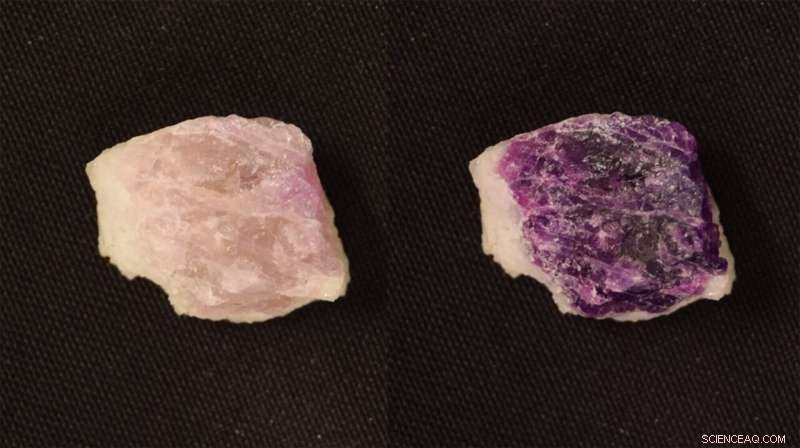
Hackmanite wordt paars onder UV-straling en de kleur vervaagt binnen een paar minuten weer naar wit onder gewoon wit licht. Dit exemplaar komt uit Groenland. Krediet:Mika Lastusaari
Tijdens het onderzoek naar hackmanite ontdekten onderzoekers dat het van kleur kan veranderen bij herhaaldelijke blootstelling aan UV-straling zonder te verslijten. De resultaten laten zien dat de goedkope hackmaniet, die gemakkelijk te synthetiseren is, ook een hoge duurzaamheid en meerdere toepassingen heeft.
Een onderzoeksgroep aan de Universiteit van Turku, Finland, onderzoekt en ontwikkelt al bijna tien jaar de eigenschappen van de hackmaniet. Toepassingen zoals persoonlijke UV-monitoring en röntgenbeeldvorming zijn ontwikkeld op basis van het vermogen van hackmanite om van kleur te veranderen.
Hackmaniet verandert van kleur van wit naar paars onder UV-straling en wordt uiteindelijk weer wit als er geen UV aanwezig is. De structurele kenmerken die dergelijke herhaalde veranderingen mogelijk maken, zijn tot nu toe onduidelijk. Nu, bij het onderzoeken van drie natuurlijke mineralen - hackmanite, tugtupite en scapolite - hebben de onderzoekers het antwoord gevonden.
Deze van kleur veranderende mineralen zijn anorganische natuurlijke materialen, maar er zijn ook organische verbindingen, koolwaterstoffen, die door blootstelling aan straling omkeerbaar van kleur kunnen veranderen. Deze koolwaterstoffen kunnen echter maar een paar keer van kleur veranderen voordat hun moleculaire structuur kapot gaat. Dit komt omdat de kleurverandering een drastische verandering in de structuur met zich meebrengt, en als deze verandering herhaaldelijk wordt ondergaan, breekt het molecuul uiteindelijk.
"In dit onderzoek ontdekten we voor het eerst dat er ook daadwerkelijk een structurele verandering is betrokken bij het kleurveranderingsproces. Wanneer de kleur verandert, bewegen natriumatomen in de structuur relatief ver weg van hun gebruikelijke plaatsen en keren dan terug Dit kan 'structurele ademhaling' worden genoemd en het vernietigt de structuur niet, zelfs niet als het een groot aantal keren wordt herhaald', meldt professor Mika Lastusaari van de afdeling scheikunde van de universiteit van Turku, Finland.
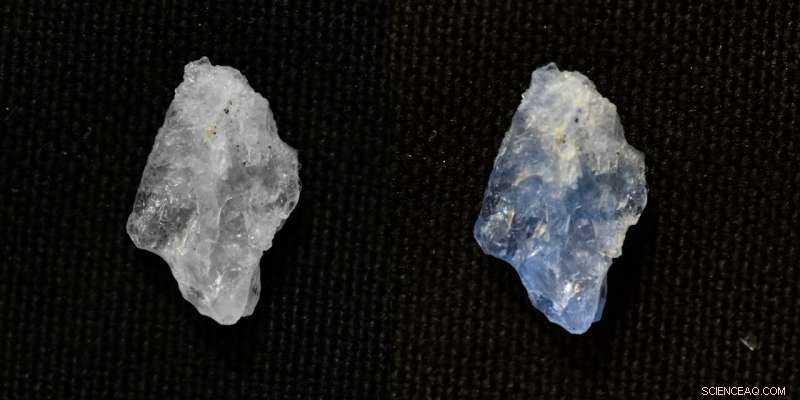
Witte scapoliet wordt blauw onder UV-straling. De kleuring en terugkeer naar wit na het verwijderen van de UV-bron duurt slechts enkele seconden, omdat atomen in de structuur korte afstanden afleggen. Scapoliet is een vrij algemeen mineraal. Dit exemplaar komt uit Afghanistan. Krediet:Sami Vuori
Onderzoekers hebben aangetoond dat het vermogen van hackmanite om af te wisselen tussen witte en paarse vormen zeer herhaalbaar is
Volgens professor Lastusaari is de duurzaamheid te danken aan de sterke driedimensionale kooiachtige algehele structuur van deze mineralen, die vergelijkbaar is met die in zeolieten. In wasmiddelen, bijvoorbeeld, stelt de kooiachtige structuur zeoliet in staat magnesium en calcium uit water te verwijderen door ze stevig in de poriën van de kooi te binden.
"In these color-changing minerals, all processes associated with the color change occur inside the pores of the zeolitic cage where the sodium and chlorine atoms reside. That is, the cage-like structure allows atomic movement inside the cage while keeping the cage itself intact. This is why minerals can change color and revert back to their original color practically indefinitely," Doctoral Researcher Sami Vuori explains.
Previously, it has been known that scapolite changes color much faster than hackmanite, whereas tugtupite's changes are much slower.
"Based on the results of this work, we found out that the speed of the color change correlates with the distance that the sodium atoms move. These observations are important for future material development, because now we know what is required from the host structure to allow the control and tailoring of the color change properties," says Doctoral Researcher Hannah Byron.
"There were no characterization methods available for the research on color changing minerals, which is why we have developed new methods by ourselves. However, it is difficult to interpret the results unambiguously based on experimental data alone. In fact, we could not have reached the present conclusions without strong support from theoretical calculations, since only the combination of experimental and computational data shows the whole picture. We owe a great many thanks to our collaborator Professor Tangui Le Bahers and his group, who have developed and advanced suitable computational methods to such detail and accuracy that would not have been possible just a few years ago," says Lastusaari.
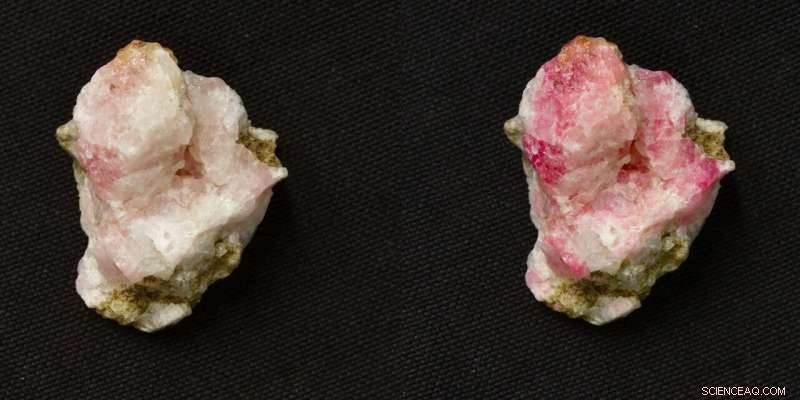
Tugtupite is a rare mineral, which turns pink when exposed to UV radiation. The return back to white takes several hours, because it requires large atomic movements. This sample is from Greenland. Credit:Sami Vuori
Hackmanite has amazing potential for applications
The Intelligent Materials Research Group at the Department of Chemistry of the University of Turku, led by Lastusaari, has long conducted pioneering research on materials with light and color-related properties, especially on hackmanite. They are currently exploring numerous applications for hackmanite, such as possibly replacing LEDs and other light bulbs with the natural mineral and using it in X-ray imaging.
One of the most interesting avenues that the researchers are currently exploring is a hackmanite-based dosimeter and passive detectors for the International Space Station, intended to be used to measure the radiation dose uptake of materials during space flights.
"The strength of hackmanite's color depends on how much UV radiation it is exposed to, which means that the material can be used, for example, to determine the UV index of Sun's radiation. The hackmanite that will be tested on the space station will be used in a similar fashion, but this property can also be used in everyday applications. We have for example already developed a mobile phone application for measuring UV radiation that can be used by anyone," explains Sami Vuori.
The paper was published in June in the PNAS journal. + Verder verkennen
Natural mineral hackmanite enables new method of x-ray imaging
 Het onthullen van de nanostructuur van hout zou kunnen helpen de hoogtelimieten voor houten wolkenkrabbers te verhogen
Het onthullen van de nanostructuur van hout zou kunnen helpen de hoogtelimieten voor houten wolkenkrabbers te verhogen Apparaat stuurt sperma tegen de stroom in om onvruchtbaarheid te helpen
Apparaat stuurt sperma tegen de stroom in om onvruchtbaarheid te helpen Verschillen tussen zinkmonomethionine en zinkpicolinaat
Verschillen tussen zinkmonomethionine en zinkpicolinaat  Versterkte fotokatalyse voor waterstofontwikkeling:toevoer van reactanten via fosfonaatgroepen
Versterkte fotokatalyse voor waterstofontwikkeling:toevoer van reactanten via fosfonaatgroepen Computationele studie laat zien hoe Ebola nucleocapside stabiliseert
Computationele studie laat zien hoe Ebola nucleocapside stabiliseert
 70 jaar hoge Donautemperaturen duiden op klimaatverandering
70 jaar hoge Donautemperaturen duiden op klimaatverandering Kleine aardbeving rammelt Californische kust bij Santa Barbara
Kleine aardbeving rammelt Californische kust bij Santa Barbara Henri upgrade naar orkaan omdat het de Amerikaanse kust bedreigt
Henri upgrade naar orkaan omdat het de Amerikaanse kust bedreigt Als een manier om klimaatverandering tegen te gaan, niet alle bodems zijn gelijk gemaakt
Als een manier om klimaatverandering tegen te gaan, niet alle bodems zijn gelijk gemaakt Vastleggen van blauwe koolstof door beter beheer van kustecosystemen
Vastleggen van blauwe koolstof door beter beheer van kustecosystemen
Hoofdlijnen
- Gekapte tropische regenwouden ondersteunen nog steeds de biodiversiteit, zelfs als de hitte aan staat
- Verschillen in mannelijke en vrouwelijke chromosomen
- Virusstamping - een veelzijdige nieuwe methode voor genetische manipulatie van afzonderlijke cellen
- Hoe ribosomen het proteoom vormen
- Het huidige begrip van dierenwelzijn sluit momenteel vissen uit, ook al voelen vissen pijn
- Afrikaanse slaapziekte:hoe de ziekteverwekker tseetseevliegen koloniseert
- Eerste levensvormen op aarde onthuld in hete lente
- Bosplantages zijn een krachtige melange voor de koffieproductie
- Fenotype: definitie, types, voorbeelden
- Cyclische hypervalente brooms werken als aryneprecursoren
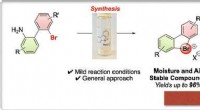
- Grote doorbraak in de productie van rode bloedcellen
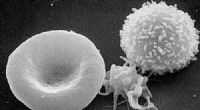
- Lastige reactiereeks krijgt een grote boost van een stroomopstelling en statistieken
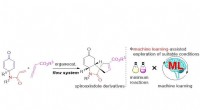
- Epoxyharsen:uitharden met een druk op de knop
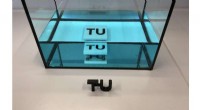
- Onderzoekers verbeteren de synthese van bismutwolframaat met een milieuvriendelijke procedure
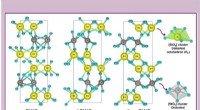
 Wat zijn enkele echte toepassingen van trigonometrie?
Wat zijn enkele echte toepassingen van trigonometrie?  Van militair tot mainstream:de evolutie van de AR-15
Van militair tot mainstream:de evolutie van de AR-15  Cherenkov Telescope Array publiceert zijn bijgewerkte wetenschappelijke case
Cherenkov Telescope Array publiceert zijn bijgewerkte wetenschappelijke case Afbeelding:Juwelen van de Malediven
Afbeelding:Juwelen van de Malediven Bereiding van 0,1 M Sucrose
Bereiding van 0,1 M Sucrose Brandweerlieden worstelen om vuur in Zuid-Californië te bedwingen
Brandweerlieden worstelen om vuur in Zuid-Californië te bedwingen Kan klimaatverandering de opkomst van rechts nationalisme voeden?
Kan klimaatverandering de opkomst van rechts nationalisme voeden? What Is Current Drain?
What Is Current Drain?
- Elektronica
- Biologie
- Zonsverduistering
- Wiskunde
- French | Italian | Spanish | Portuguese | Swedish | German | Dutch | Danish | Norway |

-
Wetenschap © https://nl.scienceaq.com

